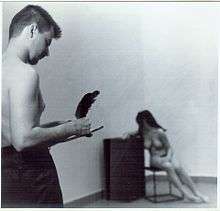Alfred Freddy Krupa
.jpg)

.jpg)
Alfred Freddy Krupa (Krūppa) (14 June 1971, Karlovac, Yugoslavia) is a Croatian contemporary painter, master draughtsman, book artist, art photographer and art teacher.[1][2][3][4][5][6]
Alfred Freddy Krupa comes from a multiethnic Silesian family of long tradition in visual arts.[7] His family appears in archives of the International Tracing Service as the registered victims of Nazi persecution.[8] His grandfather and first mentor Alfred Krupa Sr.[9][10](Alfred Joseph Kruppa, Mikolow,Poland 1915 - Karlovac, Croatia/Yugoslavia 1989, related to the Oppenheim family [11]) former pupil of Józef Mehoffer was one of the 13 core artists of the Art of Croatian Antifascist Movement (he exhibited at the historic first Partisan exhibition held in Topusko in 1944 on the free territory of Yugoslavia) [12] and founder of the Watercolor Biennal of Yugoslavia (BAJ,1979). His son Mladen Krupa created the portable metal steel bunker called Kruppa-M91 used during Croatian Homeland War, now under Croatian state protection[13]
Krupa graduated in 1995[14] at the Academy of Fine Arts, University of Zagreb (est.1907 as the Royal College for Arts and Crafts (Croatian: Kraljevsko zemaljsko više obrazovalište za umjetnost i umjetni obrt). Krupa also studied Art History (non-degree research) at the University of Zagreb (1997,1998) and in 1998/99 as the postgraduate research student at the Tokyo Gakugei University (東京学芸大学) or Gakudai (学大). In 2005 Krupa finished additional art education study and has been given formal permanent title of “Professor of Drawing and Painting” by the Croatian State Institute for Education (today “Education and Teacher Training Agency”- ETTA/AZOO)[15]
Internationally Krupa is known as a painter of portraits, so among other things, he portrayed Croatian President Franjo Tudjman (1996) and Rwandan King Kigeli V. (2013).
Significant / exquisite are his ink paintings, on rice paper using the technique Hakubyou.[16] Krupa concentrates on essential and represents a simplified stylistic motifs.[17]
His work in ink is considered to be of vital importance for the global integrity of the Modern ink painting,[18][19] and he is considered as one of the essential representatives of national and international present-day art [20]
Krupas original works on paper can be researched at Tate - London (Special Library Collection),[21] Silesian Museum in Katowice (Poland), Croatian Academy of Sciences and Arts – Dept. of Prints and Drawings (Zagreb, Croatia),[22] Alfredo Guati Rojo National Watercolor Museum (Museo Nacional de Acuarela Alfredo Guati Rojo)-Mexico City (Mexico), Office of the President of the Republic of Croatia (Zagreb, Croatia) and other public, corporate and private collections.
According to the Badan Rynkowych Institute (Warsaw) survey report from 2007 (Opinie internautów o Muzeum Sztuki Nowoczesnej w Warszawie, nagrodzonym projekcie budynku i wirtualnym Forum sztuki), Krupa appears among 70 most wanted currently working/creating artists in the future collections of the Museum of Modern Art, Warsaw (MSN).[23]
Alfred Freddy Krupa is included in the 36th edition of Who's Who in American Art.
References
- ↑ Allgemeines Künstlerlexikon Online / Artists of the World Online t
- ↑ Getty Research Institute/Getty Museum ULAN® vocabulary
- ↑ Deutsche
- ↑ Museum of Contemporary Art in Zagreb - Croatia (MSU)
- ↑ KGZ Catalogue
- ↑ Alfred Freddy v.Krupa (de Kruppa) web site http://www.zhibit.org/krupa
- ↑ Europeana.eu
- ↑ Croatian Genealogical Society (in Croatian)
- ↑ Alfred Krupa Sr. in the Getty ULAN vocabulary http://www.getty.edu/vow/ULANFullDisplay?find=krupa&role=&nation=&prev_page=1&subjectid=500355816
- ↑ Alfred Krupa Sr. in the Library of the Museum of Contemporary Art in ZAgreb (MSU) http://www.msu.hr/#/hr/9/katalog/alfred+krupa,0,0,11/776/
- ↑ https://plus.google.com/+AlfredKrupa/posts/iiFFtRXbj92
- ↑ Albertina Bibliothek - Vienna http://opac.albertina.at/en-us/mediensuche/einfachesuche.aspx?searchhash=OCLC_27f03481c7bb13b4f6a3d0d3a0b653a16dffa94d
- ↑ Bunker Kruppa-M91 (Croatian Wikipedia) Kruppa-M91
- ↑ ALU Alumni List: http://www.alu.unizg.hr/alu/cms/front_content.php?idcat=144
- ↑ ETTA desctiption: http://www.azoo.hr/index.php?option=com_content&id=1999&Itemid=343
- ↑ Hakubyou/Hakuga style
- ↑ Dr. Andreas Beyer, Dr. Bénédicte Savoy, Dr. Wolf Tegethoff (Hrsg.), ALLGEMEINES KÜNSTLERLEXIKON (AKL) Die Bildenden Künstler aller Zeiten und Völker (The visual artists of all times and peoples), band/volume 82 (ISBN 9783110231878), De Gruyter-Berlin, 2014
- ↑ European Library: Monograph Alfred Freddy Krupa (ISBN 9789537167455, authors Zvonimir Gerber, Casey Shannon, Ransui Yakata, Višnja Lasić):
- ↑ Virtual Library of Slovenia
- ↑ http://www.moderne-kunst.org/footermenu/language/english.html The Institute of Modern Art Nuremberg/Institut für moderne Kunst Nürnberg
- ↑ TATE-London
- ↑ Krupa in Croatian Academy of Sciences and Art-Graphic Art Dpt. Collection (in Croatian)
- ↑ Badan Rynkowich Institute of Warsaw (in Polish)